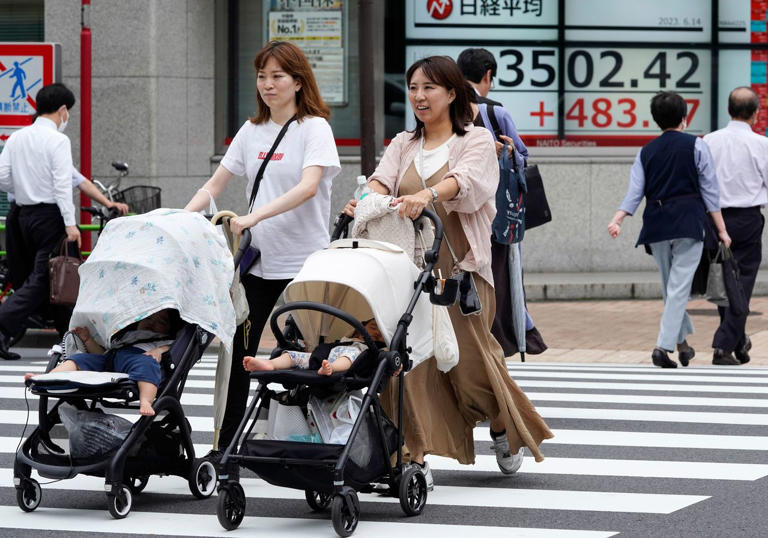As the global economic landscape reshapes in the wake of the pandemic, the United States has emerged as an unexpected beneficiary, outperforming many Asian economies that weathered the pandemic relatively well. Despite the challenges posed by the end of the pandemic-era export boom and Washington’s aggressive stimulus measures, the U.S. has found itself in a favorable position, thanks in part to significant post-pandemic immigration flows.
Immigrants have played a crucial role in mitigating inflationary pressures by expanding the workforce, particularly in the face of declining birthrates. Their influx is projected to bolster economic growth and public finances for years to come. Goldman Sachs estimates that above-trend immigration in recent years will contribute to a 0.3 percentage point increase in potential growth, reaching 2.1% in 2024. In contrast, economies like Japan and Taiwan have struggled to sustain growth momentum, with Japan experiencing minimal expansion in late 2023 and Taiwan registering modest growth of just 1.3% last year.
While immigration has historically been a contentious issue in the U.S., Northeast Asian countries grapple with even greater challenges in this regard. As their populations age rapidly, the ramifications of restrictive immigration policies become increasingly evident. Aging populations strain pension systems that rely on contributions from younger workers to fund benefits. Moreover, declining populations exacerbate the vulnerability of export-oriented economies like Taiwan and South Korea to fluctuations in the semiconductor market. Additionally, increased government debt issuance may hinder private investment and compete with other critical priorities such as national defense.
Recognizing the urgency of addressing these demographic challenges, governments in Taipei, Tokyo, and Seoul have initiated measures to mitigate the impact of aging populations. However, entrenched political opposition to reform and the onset of population decline pose significant obstacles to sustaining economic dynamism in Asia.
Research underscores the vital connection between migration and economic growth, demonstrating that higher levels of immigration relative to total employment can significantly boost overall output in advanced economies. Importantly, productivity gains resulting from increased immigration benefit native workers as well, as immigrants often bring diverse skill sets that enhance overall economic efficiency and accelerate growth.
The demographic disparities between the United States and Northeast Asian countries like Japan, Taiwan, and South Korea underscore the profound impact of immigration on economic growth and fiscal stability. While the U.S. has experienced population growth fueled largely by immigration, Asian nations grapple with declining populations and aging workforces.
Japan and Taiwan have witnessed population declines of nearly 2% and 1%, respectively, since 2019, contrasting sharply with the 1.4% population growth in the U.S., driven in significant part by new foreign-born residents. The long-term ramifications of these demographic trends are substantial, with projections indicating that the current immigration surge in the U.S. will contribute to a 2% larger economy by 2034 and a lower federal budget deficit.
Moreover, immigration has yielded immediate benefits for the U.S. economy, helping to mitigate labor market pressures and contribute to a soft landing characterized by declining inflation without significant increases in unemployment. The flexible immigration policies of the U.S., particularly along its southern border, serve as a safety valve during economic overheating, drawing in low-skilled workers and mitigating the risk of wage-price spirals and persistent inflation.
In contrast, Japan’s tightly controlled borders and shrinking labor force limit its policy flexibility, exacerbating challenges associated with aging demographics and labor shortages. Despite narrowly avoiding recession and witnessing a notable wage increase negotiated by unions, Japan faces the delicate task of balancing inflationary pressures with real consumption levels. The nation’s aging population and declining birth rates further complicate efforts to sustain economic growth and manage public debt, which stands at a staggering 260% of GDP.
Similarly, South Korea and Taiwan confront the urgent need for immigrant labor to counteract declining birth rates and bolster economic vitality. Both countries have implemented measures to attract skilled foreign workers and address labor shortages in key industries. However, incremental steps may prove insufficient in the face of mounting demographic challenges and evolving economic priorities.
To remain competitive and sustain economic growth, Northeast Asian countries must embrace immigration as a vital component of their economic strategies. Embracing demographic realities and adopting proactive immigration policies are essential steps toward ensuring long-term prosperity and resilience in an increasingly dynamic global landscape.
